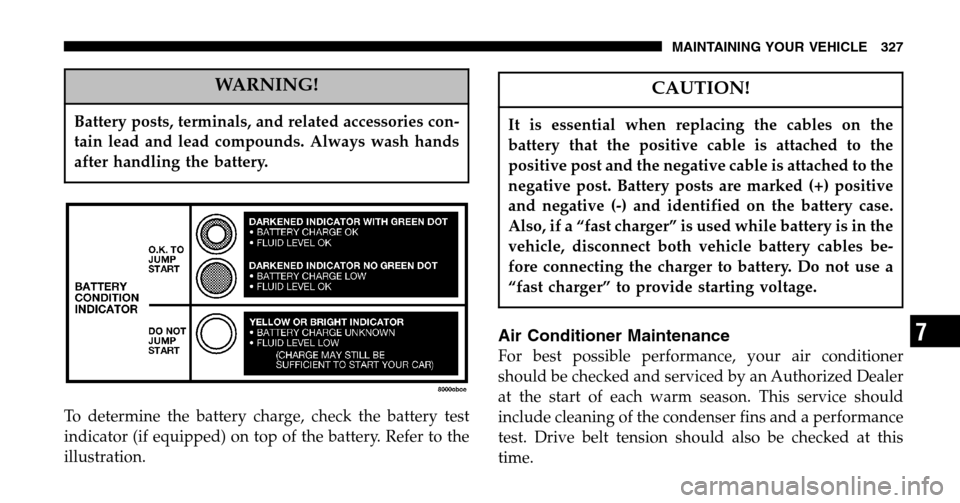Page 311 of 424
MAINTAINING YOUR VEHICLE
CONTENTS
�3.7L Engine ...........................314
� 2.8L Turbo Diesel Engine .................315
� Onboard Diagnostic System — OBD II ........316
▫ Loose Fuel Filler Cap Message ............316
� Emissions Inspection And Maintenance
Programs ............................317
� Replacement Parts ......................318
� Dealer Service .........................318
� Maintenance Procedures ..................319 ▫
Engine Oil ..........................319
▫ Drive Belts — Check Condition And Tension . . 323
▫ Spark Plugs .........................324
▫ Catalytic Converter ....................324
▫ Crankcase Emission Control System ........326
▫ Air Cleaner Filter .....................326
▫ Maintenance-Free Battery ................326
▫ Air Conditioner Maintenance .............327
▫ Power Steering Fluid Check ..............328
7
Page 317 of 424

the fuel filler cap properly to turn the message off (light
will time out). If the problem continues, the message will
appear the next time the vehicle is started.
EMISSIONS INSPECTION AND MAINTENANCE
PROGRAMS
In some localities, it may be a legal requirement to pass
an inspection of your vehicle’s emissions control system.
Failure to pass could prevent vehicle registration. For states which have an I/M (Inspection and
Maintenance) requirement, this check verifies the
following: the MIL (Malfunction Indicator Lamp)
is functioning and is not on when the engine is running,
and that the OBD (On Board Diagnostic) system is ready
for testing.
Normally, the OBD system will be ready. The OBD
system may notbe ready if your vehicle was recently
serviced, if you recently had a dead battery, or a battery replacement. If the OBD system should be determined
not ready for the I/M test, your vehicle may fail the test.
Your vehicle has a simple ignition key actuated test
which you can use prior to going to the test station. To
check if your vehicle’s OBD system is ready, you must do
the following:
1. Insert your ignition key into the ignition switch.
2. Turn the ignition to the ON position, but do not crank
or start the engine.
3. If you crank or start the engine, you will have to start
this test over.
4. As soon as you turn your key to the ON position, you
will see your MIL symbol come on as part of a normal
bulb check.
5. Approximately 15 seconds later, one of two things will
happen:
MAINTAINING YOUR VEHICLE 317
7
Page 318 of 424

a. The MIL will flash for about 10 seconds and then
return to being fully illuminated until you turn off the
ignition key or start the engine. This means that your
vehicle’s OBD system is not readyand you should not
proceed to the I/M station.
b. The MIL will not flash at all and will remain fully
illuminated until you turn off the ignition key or start
the engine. This means that your vehicle’s OBD system
is ready and you can proceed to the I/M station.
If your OBD system is not ready,you should see your
authorized dealer or repair facility. If your vehicle was
recently serviced or had a battery failure or replacement,
you may need to do nothing more than drive your
vehicle as you normally would in order for your OBD
system to update. A recheck with the above test routine
may then indicate that the system is now ready.
Regardless of whether your vehicle’s OBD system is
ready or not ready, if the MIL symbol is illuminated during normal vehicle operation, you should have your
vehicle serviced before going to the I/M station. The I/M
station can fail your vehicle because the MIL symbol is on
with the engine running.
REPLACEMENT PARTS
Use of genuine Mopar
�parts for normal/scheduled
maintenance and repairs is highly recommended to in-
sure the designed performance. Damage or failures
caused by the use of non-Mopar �parts for maintenance
and repairs will not be covered by the manufacturer’s
warranty.
DEALER SERVICE
Your dealer has the qualified service personnel, special
tools and equipment to perform all service operations in
an expert manner. Service Manuals are available which
include detailed service information for your vehicle.
Refer to these manuals before attempting any procedure
yourself.
318 MAINTAINING YOUR VEHICLE
Page 326 of 424

Crankcase Emission Control System
Proper operation of this system depends on freedom
from sticking or plugging due to deposits. As vehicle
mileage builds up, the PCV valve and passages may
accumulate deposits. If a valve is not working properly,
replace it with a new valve. DO NOT ATTEMPT TO
CLEAN THE OLD PCV VALVE!
Check ventilation hose for indication of damage or
plugging deposits. Replace if necessary.
Air Cleaner Filter
Under normal driving conditions, replace the air filter at
the intervals shown on “Maintenance Schedule A.” If,
however, you drive the vehicle frequently under dusty or
severe conditions, the filter element should be inspected
periodically and replaced if necessary at the intervals
shown on “Maintenance Schedule B.”
WARNING!
The air cleaner can provide protection in the case of
engine backfire. Do not remove the air cleaner
unless it is necessary for repair or maintenance.
Make sure that no one is near the engine compart-
ment before starting the vehicle with the air cleaner
removed. Failure to do so can result in serious
personal injury.
Maintenance-Free Battery
Your vehicle is equipped with a maintenance-free battery.
You will never have to add water, nor is periodic main-
tenance required.
326 MAINTAINING YOUR VEHICLE
Page 327 of 424

WARNING!
Battery posts, terminals, and related accessories con-
tain lead and lead compounds. Always wash hands
after handling the battery.
To determine the battery charge, check the battery test
indicator (if equipped) on top of the battery. Refer to the
illustration.
CAUTION!
It is essential when replacing the cables on the
battery that the positive cable is attached to the
positive post and the negative cable is attached to the
negative post. Battery posts are marked (+) positive
and negative (-) and identified on the battery case.
Also, if a “fast charger” is used while battery is in the
vehicle, disconnect both vehicle battery cables be-
fore connecting the charger to battery. Do not use a
“fast charger” to provide starting voltage.
Air Conditioner Maintenance
For best possible performance, your air conditioner
should be checked and serviced by an Authorized Dealer
at the start of each warm season. This service should
include cleaning of the condenser fins and a performance
test. Drive belt tension should also be checked at this
time.
MAINTAINING YOUR VEHICLE 327
7
Page 350 of 424

Cavity Fuse Description
13 10 Amp Red Body Control Module/ CMTC/Cluster/Pass. Airbag
On,Off Indicator, Auto Day-
light Mirror/Light Bar
Switch (Renegade Only)
14 10 Amp Red PDC Fuel Pump/AC Clutch, Starter Relay/Engine
Controller/Transmission
Controller (Diesel Only)
15 Spare
16 20 Amp Yellow Power Outlet (Rear)
17 15 Amp Blue Rear Wiper
18 20 Amp Yellow Radio Choke & Relay
19 20 Amp Yellow Frt Fog Lights/Trailer Tow Stop and Turn Lights
20 Spare
21 10 Amp Red RadioCavity Fuse Description
22 20 Amp Yellow Power Sunroof Relay/ Antenna Module (Export
Only)
23 Spare
24 10 Amp Red PDC Blower Motor
25 10 Amp Red Heated Seat Switches/HVAC Control Head/Trailer Tow
Battery Charge
26 10 Amp Red Headlight High Beam Right
27 10 Amp Red Headlight High Beam Left
28 Spare
29 10 Amp Red Heated Mirrors/Rear Win- dow Defroster Indicator
30 15 Amp Blue Heated Seat Module
31 Spare
32 10 Amp Red Wiper Switch/Front and Rear Wipers
33 10 Amp Red SKIM Module/Data Link Connector
350 MAINTAINING YOUR VEHICLE
Page 351 of 424

Cavity Fuse Description
34 15 Amp Blue Body Control Module/ Cluster/Interior Lights,
Hands Free Module/Radio/
CMTC/ITM Module & Siren
(Export Only)
35 Spare
36 10 Amp Red Airbag Control Module/ Occupation Classification
Module (Right Front Seat)
37 10 Amp Red Airbag Control Module
38 10 Amp Red ABS Controller/Shifter As- sembly
39 10 Amp Red Hazard Flasher (Turn Signals)/Backup Lamp
Switch (Manual Transmission
Only)/Transmission Range
Switch (Automatic Transmis-
sion Only)Underhood Fuses (Power Distribution Center)
Your vehicle is equipped with an electrical power distri-
bution center located in the engine compartment near the
battery. This power center houses plug-in “Cartridge”
fuses which replace in-line fusible links. The power
center also contains “Mini” fuses and plug-in full and
micro ISO relays. A label inside the latching cover of the
center identifies each component for ease of replacement,
if necessary. “Cartridge” fuses and relays can be obtained
from your authorized dealer.
MAINTAINING YOUR VEHICLE 351
7
Page 355 of 424

Cavity Fuse Description
R31 Half ISO Relay Wiper On/Off
R32 Half ISO Relay Wiper Hi/Lo
R33 Full ISO Relay H. Blower
R34 Full ISO Relay Rad. Fan Hi
R35 Half ISO Relay A/C Clutch
R36 Half ISO Relay Viscous Heat
R37 Open
R38 Open
R39 Full ISO Relay ASD
R40 Full ISO Relay Rad. Fan LoVEHICLE STORAGE
If you are leaving your vehicle dormant for more than 21
days you may want to take steps to protect your battery.
You may:
•Remove Cartridge fuse #15 in the Power Distribution
Center labeled Ignition-Off Draw (IOD).
•Store the removed IOD fuse in the Power Distribution
Center location #11 labeled “IOD Storage.”
•Or, disconnect the negative cable from the battery.
•Anytime you store your vehicle, or keep it out of
service (i.e. vacation) for two weeks or more, run the
air conditioning system at idle for about five minutes
in the fresh air and high blower setting. This will
insure adequate system lubrication to minimize the
possibility of compressor damage when the system is
started again.
MAINTAINING YOUR VEHICLE 355
7